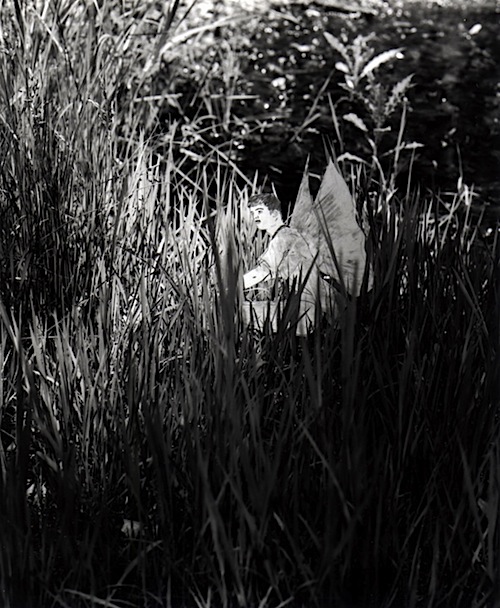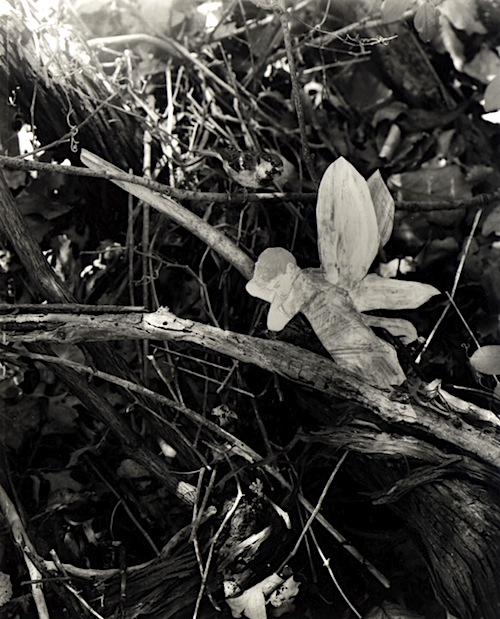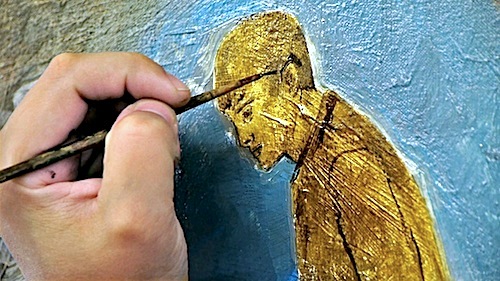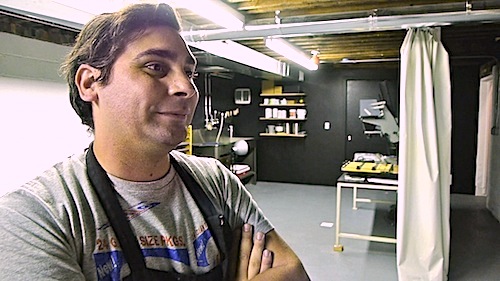[This blog series is about artists and curators who chose to work in Miami, and those who’ve been based here that decided to leave. For more info, read the introduction here.]
Wet Heat, our filmmaking project, produced a feature documentary on the formerly Miami-based painter Hernan Bas,“miamiHeights,” completed in 2009 after two years of following the young artist’s ascending career. This post and accompanying new short video marks the first time our producer Grela Orihuela and I revisited the artist, who has relocated to Detroit.
It was the day Hernan Bas–at age 31 the most successful Miami-based artist–knew he had to leave his home city. At the height of Miami’s most important art season, “people starting knocking at the door of the studio asking to come in and view my work, and I didn’t know who they were.” His studio assistant, who’d answered the door and queried the strangers, sent them away. That was three Basels* ago.
*(A ‘Basel’ is how the Miami art community measures time, a unit equal to 361 days; this unit is also known as “between Basels,” a period which runs from the day after Art Basel Miami Beach closes to the day before it opens.)
“That kind of access, being in the middle of a whole scene, it just became a little too much for me.” A street address listing Hernan Bas Studio had been published on an unofficial Art Basel map of Wynwood, the ever-transitioning Miami neighborhood highest in gallery density. Spunky art tourists assumed they could drop in anytime to view the celebrated artist making work in his natural habitat. Hernan laughs, “I’m very friendly and willing to talk to people, but, make an appointment!”
At that moment started a careful, deliberate move to Detroit, where his partner Peter Rozek had spent many formative years, a city Hernan had visited and enjoyed, a city offering abundant space where his astute savings could buy a home and studio to remodel just as he needed. A place where at the very least he could buy time, for himself, to get work done, more than a thousand miles from Miami. “You have to really like me to come visit me in Detroit. I don’t have any strangers knocking on my studio door.”
A bike-ride from his finely detailed, thoughtfully rejuvenated 1920s stately home is his multi-level studio, its renovations just now completed. At ground level, a former storefront shop is his painting space, the ceilings tall enough for even the largest of canvases he’s been known to produce. Today he’s near completion of a painting destined for a Hite Foundation group show in Korea.
The painting has a gold-leaf base layer (artificial variety), a riff on a previous series with a silver leaf undercoat that enabled a “weird luminosity.” This painting is his first since returning from a long Asian sojourn, his “getting-back-into-the-groove painting.” After each break in his workflow, Hernan resumes with a work he needs to figure out, a step forward in a technical, technique or idea direction that places the next part of his timeline ahead of the last one. It can be something straightforward like switching out base coats to evoke a Renaissance glow, or, something divergent like putting down the brushes altogether and disappearing into the basement.
Hernan’s studio basement is a full-featured traditional photographic darkroom, the kind with enlargers that project sheet film images onto chemically treated paper which is hand-submerged in successive trays of yet more chemicals, all of that in near-darkness. Quality is never assured until the soaking wet paper dries and the whole process is done. It’s a linear experience, no going back to adjust middle steps; less than perfect results mean tearing up the print and doing it again.
Hernan started his fledgling art career with photography before discovering his powerhouse entry into the art world was through painting. He loves the medium’s intrinsic risk and uncertainty, the notion of working at it to get it just right. His return to photography was formalized with a show at Peter Kilchman in Zurich last summer, and continued just last month in Korea at Seoul’s PKM Trinity Gallery, places where collectors might be more open to a departure from his painting work most in demand.

Hernan Bas. “Untitled 10,” 2011. Photographic print. From the series “A bunch of fairies.” Courtesy of the artist.
What he’s been photographing is fairies, the diminutive kind you see hovering among the reeds or perched on leaves near creek beds and tree lines. With his heavy large-format camera and tripod he treks out to the kind of quiet, isolated spots best suited for fairies and patiently sets up optimal angles, waiting for just the right light. Making the fairies is the easy part, catching them on film is the thing. It’s laborious and elaborate, requiring as much thinking and planning, but less production time, than painting. And it’s an adventure. “I’ve never done plein air painting, so for me it’s like going into the woods for the first time. The photos are my version of that. I never leave the studio so it’s nice to be making art outside that door. And in Detroit it’s easier to shoot in the middle of nowhere than in Miami.” Easier how? “Without being bothered. Or eaten by an alligator.”
Not “being bothered” is the quality of life Hernan was needing that led to a departure from Miami. “I’ve always been a little outside of it all to begin with. I don’t go to openings like I should, I’m not terribly involved in the community as much as I used to be. It got to the point where a lot was expected of me.” He yearned for “a place to just work and not be distracted by so many visits. After a while you don’t have any time to work because you’re always hosting somebody.” Just saying “no” to a stream of requests sounds easy enough, but all that rejection builds resentment; the resulting vibe is demoralizing in a small town where everybody goes to everything and the art scene is highly participatory. The self-defeating wrong outcome of his success was simple: not enough time to paint. He had one role too many to succeed at both, so he quit the job of Miami’s resident art star.
(The above video is a scene from our 2009 feature documentary about Hernan Bas.)
Now spending most of his time in Detroit, Hernan lives the work ethic that suits him. He cites one downside, the absence of studio-mates. Although that’s by choice, it’s been a surprisingly significant change in the tenor of his practice. “Here, I really am working on paintings by myself, I have no immediate input. In the past I’d ask someone and in minutes they could tell me, ‘No, honey, that’s cheesy, don’t do that. Don’t put a pinwheel in his hand.’ Those kind of quick decisions I now have to live with longer, I don’t have people to bounce things off of as easily.” The frenetic activity of a shared studio had other noticeable affects. “There’s sort of a calm that’s come over the work, and the characters in the work. What used to be melancholy before is now a resolve. Maybe I’m just chilling out as a person, and the anxiety level in the characters has diminished. Miami can give you some anxiety!”
It’s odd to think of laid-back Miami as a place of anxiety, but success in any city is a burden that can mess up a young artist, and big success is a bigger burden. “I just want to be Hernan, not ‘Hernan,’ and I don’t want to fall into the same trap. Some people are already calling me a Detroit artist, and I say, ‘No, it’s too early. I just happen to live here.’”
At great cost and effort, Hernan created a new circumstance. He’s only lightly involved in the local art scene, where he’s known as a successful painter from out of town who keeps to himself. He bikes to work with detours through idyllic Elmwood Cemetery on sweltering days, trudges through hip-deep snow on other days. He’s the lone occupant of a large studio devoid of instant ancillary opinions. “It’s been a good thing in a way, because now I have to solve my own problems as a painter.”
It’s seems pretty certain that in a rare and assiduous way, Hernan knows how to solve problems as a painter.








